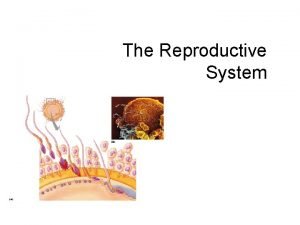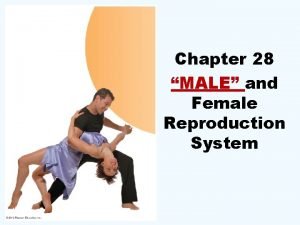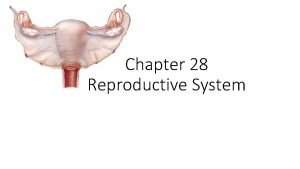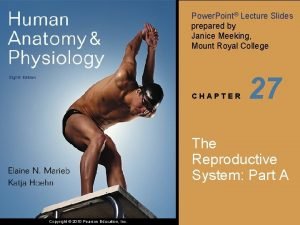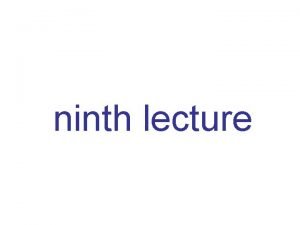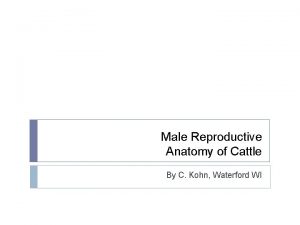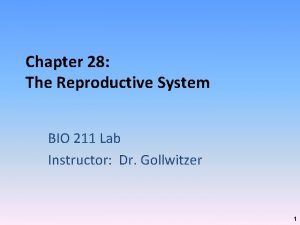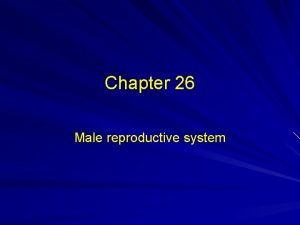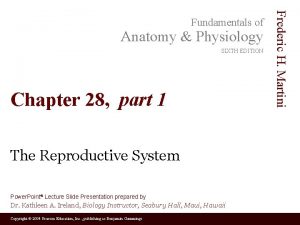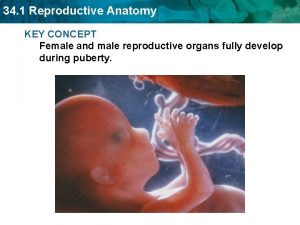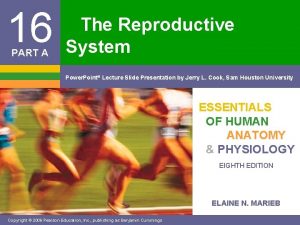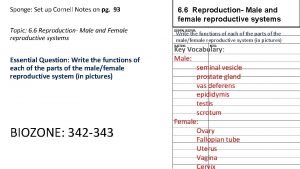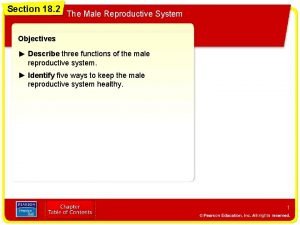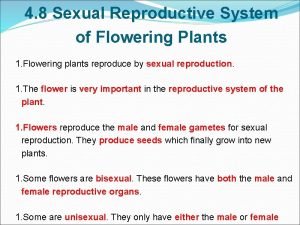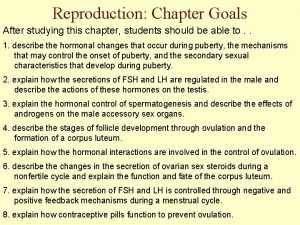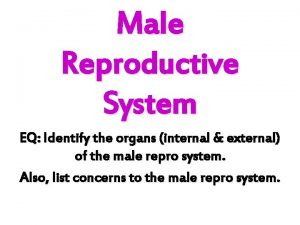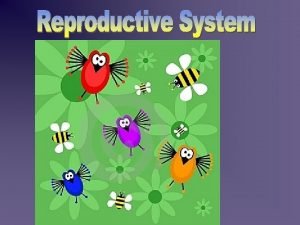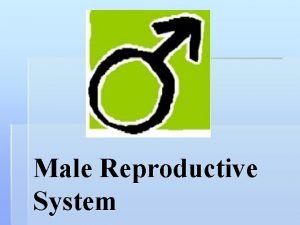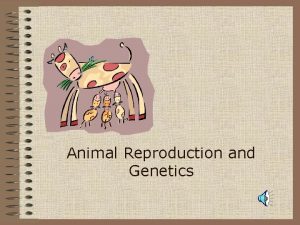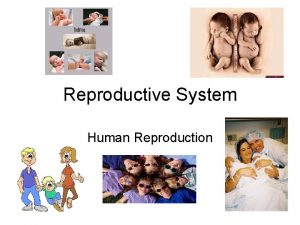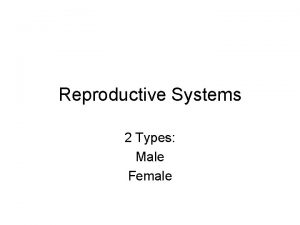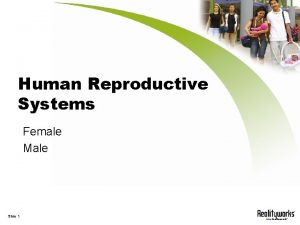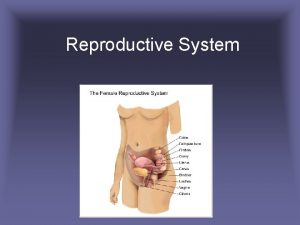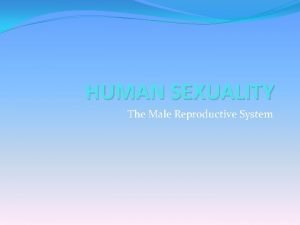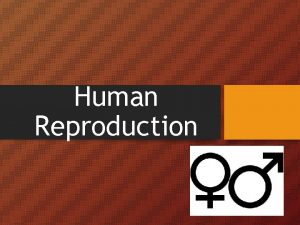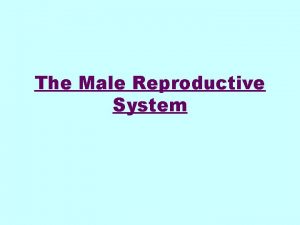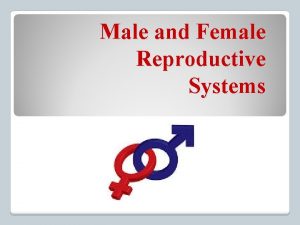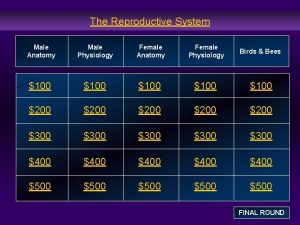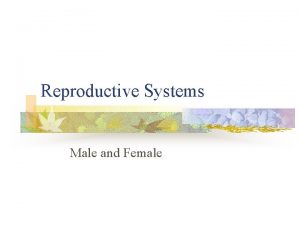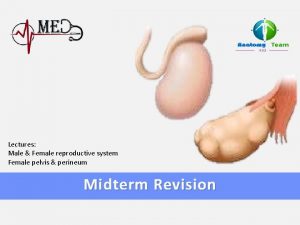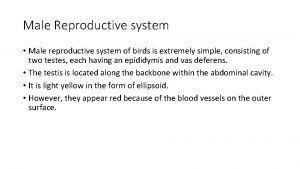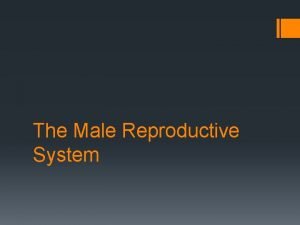HUMAN REPRODUCTIVE SYSTEM Male reproductive system Female reproductive









































- Slides: 41

HUMAN REPRODUCTIVE SYSTEM Male reproductive system Female reproductive system • 1

• Primary sex organs-organs at birth – Ovaries in female – Testes in male 2

Secondary sexual characters-at puberity stage(10 -15 yrs old) – In males • Appearance of hairs over the face, under arm pit and around the sex organ • Deepening of voice • Muscularity • Enlargement of the sex organ • Starting of sperm production _in females • Appearance of hairs under arm pit and around the sex organ • Sharpening of voice • Softening of skin • Widening of hip bone • Enlargement of breast and the sex organ • Starting of menstruation 3

Organs • Testes • Epididymus • Vas deference(sperm duct) • Accessory glands • Urethra 4

5

Testes(Male gonads) • Paired • Kept in skin sac, scortum hanging outside the abdominal cavity. • Produce – Male gamete, sperm cells in the seminiferous tubules – Androgen hormone in the interstitial tissue 6

7

Spermatogenesis • Male gamete formation • Meiosis(reduction division) • Spermermatocyte sperm cell (spermatozoa) 8

Diploid (2 n) Haploid (n) n n n 9

Epididymus • Coiled tubes over the testes • Store sperm cells temporarily 10

Vas deference • Sperm duct carrying sperm cells to the urethra • Sperm cells here mix with seminal fluid – Fructose from seminal vesicles – Alkaline secretion from prostate gland – Mucus from coper’s gland • Semen seminal fluid sperm cells – is the fluid coming out through urethra 11

Check points 1. Sperm cells are suspended in the scrotum, outside the body, so as to keep them---------------. 2. Testosterone, the male sex hormone, is secreted by cells-------------. 3. The acrosome contains--------- to help penetrate the egg. 4. The period of time during which the reproductive organs mature fully is called----------------12

Organs • Ovaries • Fallopian tubes • Uterus • Birth canal(vagina) 13

14

15

Ovaries • Paired • Contain thousands of developing follicles • Each developing follicles contains an egg • Matured follicle (graafian follicle) finally ruptures to release the matured egg • Secrete female sex hormone 16

Oogenesis • Female gamete (ovum) formation • Meiosis • Oocyte ovum (Diploid cell) (haploid cell) 3(degenerate) 1 cell 1(ovum) 17

Diploid 2 n Haploid n 18

Fallopian tube(oviduct) • Paired small tube for fertilization • The release of egg from ovary to this small tube is called ovulation • At the 14 th day of menstruation, ovulation occur 19

st 1 day 28 th 21 nd 7 th day 14 th 20

Uterus(womb) • Bigger muscular tube in which embryo attached and developed • The inner lining of uterus, endometrium, is rich in blood supply • The lower tip is cervix 21

Menstrual cycle • Every 4 weeks ovary release egg to oviduct • Ostrogen act on uterus – The lining become thick(blood vessels developed) • FSH & LH act on ripe follicle • After ovulation, follicle developed to corpus luteum – Produce progestron-thicken more the womb • If no conception at the 28 th day the thickened womb wall breaks down – Menstruation 22

23

Menstruation • 1_7 days Progestrone Ostrogen • 14_21 • 7_14 days FSH & LH • 12_15 days 24

Fertilization, Development and Birth • Union of sperm nucleus(n) with ovum nucleus(n) in the fallopian tube – Zygote(2 n) formed • With in one week embryo formed in this tube • Embryo taken to uterus 25

• Implantation on utrine wall • Fetus developed after 8 weeks – The first organ developed is heart • The fetus enclosed with fluid containing membrane – Amnion – Amniotic fluid • Placenta_fetus nourishing tissue 26

27

• Umbilical cord connects placenta with fetus • Material exchange takes place between fetus blood and mother’s blood in placenta – Oxygen – Carbon dioxide – Metabolic wastes – Alcohol – Drug – Substances in smoke of cigarette – But not HIV • The two bloods never mix at normal case 28

29

Mother’s blood O 2, food Fetus Metabolic wastes eg. CO 2 Placenta fetus Mother’s blood 30

Birth • Coming out of fetus from womb head first. Why? – labour • 38 weeks are human gestation period • Events – Utrine wall contracts and pushes fetus – Cervix widen – Amnion breaks and fluid escapes out – The head of fetus – Umbilical cord cut – Placenta moved out next to fetus 31

Twins Fraternal twins Identical twins From two ova Single ovum divides to two Sex, color, height, hair etc may not be identical Sex, color, height, hair etc are identical 32

In vitro fertilization • Test _ tube babies • Fertilization is in laboratory glassware • Embryo is implanted in the womb 33

Family planning (contraceptive methods) 1. Natural method Ø Avoiding intercourse in fertility period Ø 12_16 Ø How we know? Ø Calendar method Ø Body temperature rise after ovulation(0. 5 oc) Ø Mucus secreted from cervix and birth canal lining more fluidy 34

2. Artificial methods of contraception A. Physical or barrier methods Male condom Female condom diaphrag m Nature Rubber sheath Latex sheath Rubber cup Used on/in Penis Birth canal Cervix Uterus Hiv prevention √ √ √ × 98% 98% Effectiveness 98% Inra utrine device (IUD) Copper coil 35

36

B. Hormonal method Pills injection Implant Content Estrogen And Progesterone hormone Hormone In small silicone capsule Site oral Upper arm Buried in the upper arm effect • Prevent ovulation • Mucus secretion from cervix Period Daily 3 months/injection 5 years Effective ness 99% 99% 37

38

C. Sterilization Vasectomy Tubectomy • Cutting and tying of sperm duct • 100% reliable • Sperm production unaffected • Sexual desire and feelings unaffected • Cutting and tying of fallopian tube • 100% reliable • Ovary unaffected • Menstruation contineue • Sexual desire and feelings unaffected 39

D. Spermicides • Chemicals killing or immobilizing sperms • Forms _ cream, gel, or foam applied in birth canal • Very reliable if used with condom and diaphragm 40

41
 Male and female reproductive system
Male and female reproductive system Parts of male and female reproductive system
Parts of male and female reproductive system Similarities between male and female reproductive system
Similarities between male and female reproductive system 90/2
90/2 Circumcised dick
Circumcised dick Cartilaginous fish vs bony fish
Cartilaginous fish vs bony fish Female reproductive ducts
Female reproductive ducts Function of the vagina
Function of the vagina Reproductive hygiene
Reproductive hygiene Anatomy of the reproductive system exercise 42
Anatomy of the reproductive system exercise 42 Male reproductive system lateral view
Male reproductive system lateral view Dot quizlet
Dot quizlet Chapter 16 reproductive system
Chapter 16 reproductive system Reproductive physiology
Reproductive physiology Plants reproductive system
Plants reproductive system Art-labeling activity: the male reproductive system, part 1
Art-labeling activity: the male reproductive system, part 1 Male reproductive system information
Male reproductive system information Where is the sperm stored
Where is the sperm stored Bull reproductive system parts and functions
Bull reproductive system parts and functions Prostate
Prostate Male reproductive system plants
Male reproductive system plants Disease traductor
Disease traductor Female reproductive system of pila
Female reproductive system of pila Fetal pig excretory system diagram
Fetal pig excretory system diagram Male plant reproductive system
Male plant reproductive system Figure 28-2 the female reproductive system
Figure 28-2 the female reproductive system Primary sex organ of the male reproductive system? *
Primary sex organ of the male reproductive system? * Lesson 20.2 the male reproductive system
Lesson 20.2 the male reproductive system Rabbit reproductive organs
Rabbit reproductive organs Figure 28-1 the male reproductive system
Figure 28-1 the male reproductive system Colon function in male reproductive system
Colon function in male reproductive system Figure 16-1 male reproductive system
Figure 16-1 male reproductive system Female reproductive system label
Female reproductive system label Pathway of semen
Pathway of semen Male plant reproductive system
Male plant reproductive system Summary of male reproductive system
Summary of male reproductive system Function of uterus ppt
Function of uterus ppt Cat male reproductive system
Cat male reproductive system What is seminal vesicle in male reproductive system
What is seminal vesicle in male reproductive system Male reproductive system muscles
Male reproductive system muscles Functions of bulbourethral gland
Functions of bulbourethral gland Basic animal reproduction crossword
Basic animal reproduction crossword


